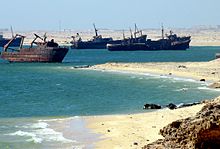Ship graveyard

A ship cemetery is a place where numerous ships have sunk or stranded beyond recovery , have been sunk or are left to decay.
Ship graveyards in difficult waters
The most famous ship cemetery in the world is due to the notorious weather and current conditions of the waters there in the area around Cape Horn off the southern tip of South America. According to European statistics, more than 800 ships sank in the region and over 10,000 people lost their lives there.
Another important ship cemetery is False Bay on the coast of South Africa with 300 shipwrecks . False Bay is located directly east of the headland, on which Cape Point and the Cape of Good Hope are the most south-westerly points of South Africa. In the past, sailing ships coming from the east sometimes confused the Cape Hangklip east of False Bay with the headland and its capes that mark the geographical point from which the ship route led back north. So the ships sailed northwards into the bay between the capes, which was then given the name "False Bay" (in German: False Bucht ).
A large ship graveyard is located in the North Pacific off the coast of North America. The Cemetery of the Pacific ( English Graveyard of the Pacific , en ) extends roughly from Tillamook Bay to the northern tip of Vancouver Island and thus includes the mouth of the Columbia River with the Columbia Bar and the entrance to Juan de Fuca Strait . Due to the difficult weather, current and coastal conditions, more than 2000 ships sank there.
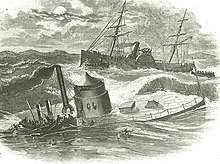
Two regions (as the "Graveyard of the Atlantic" English Graveyard of the Atlantic , s ) denotes: Sable Iceland is a sandy island in the Atlantic , the Canadian province of Nova Scotia is one. The 42 km long, narrow island, which is about 160 km southeast of Canso on the Cape of the same name on the peninsula of Nova Scotia and around 290 km east-southeast of Halifax , is one of the most remote places in Canada. It is notorious as the "Atlantic cemetery" because since 1583 over 350 shipwrecks on its coast have killed over 10,000 sailors. The reason for this is that the island is very far off the coast, close to shipping routes , and fog in this area prevents visibility for a third of the year. Many of the shipwrecks are still on the island's coast today.
The area around Cape Hatteras in front of the island chain of the Outer Banks of North Carolina , USA , is also called the "Atlantic Cemetery" . Over 5000 ship losses have been documented there since the early 16th century. Today there are no more remains of most of them: On documents from recreational divers, z. B. only noted the positions of about 135 wrecks.
Further examples of ship cemeteries range from the British Land's End across parts of the Icelandic coast (in particular Snæfellsbær , which suffered 700 deaths in the 17th and 18th centuries alone) to the reef region of Abu Nuhas in the Red Sea . The Namibian Skeleton Coast forms a ship cemetery “on land” , where numerous ships have stranded and there are still some wrecks on the beach today; The Skeleton Coast got its name not because of the ship accidents itself, but because of the Namib Desert , which lies directly on the coast , which usually left stranded people with little chance of survival.
The Bermuda Triangle Ship Cemetery , on the other hand, can be described as a myth , a sea area in the Atlantic in which a strikingly large number of ships and aircraft are said to have been lost under sometimes mysterious circumstances. In fact, the number of vehicles missing there is inconspicuous (see separate article).
Ship graveyards from sea battles
A multitude of wars and naval battles has resulted in high losses of ships. This includes:
Battle of Salamis 480 BC Chr.
In the greatest sea battle in ancient times, the Battle of Salamis in 480 BC. BC, the Greek as well as the Persian side sank enemy ships in the region around Salamis in Greece . The data on the size of the fleets are not uniformly handed down, but modern science assumes that about 380 Greek ships faced about 500 Persian ships. According to Diodorus Siculus, 40 Greek and 200 Persian ships sank during the one-day battle ; In addition, after Herodotus, many Persians died because they could not swim, while the Greeks saved themselves by swimming on the nearby island of Salamis. However, the information is difficult to verify.
Battle of Lepanto (1571)
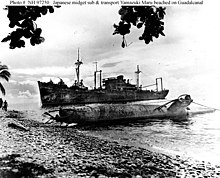
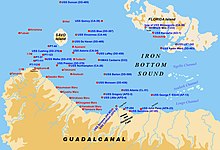
On October 7, 1571, the fleet of the Christian Mediterranean Powers (so-called Holy League under the leadership of Spain) and the fleet of the Ottoman Empire fought off the Greek Strait of Lepanto (between Patras and the southern Ionian Islands ). The Ottomans finally succumbed, not least because of the new use of eleven galeas on the Spanish-Christian side; the high-sided ships could not be boarded , but fired in all directions. They destroyed 35% of the Ottoman fleet alone. On the Hispanic Christian side, 211 ships took part in the battle, 13 of which were lost. On the Ottoman side, 260 ships were involved; 80 ships were sunk and 30 were put aground. Many ships are said to have sunk just off the island of Oxia .
Many researchers searched unsuccessfully for the remains of the naval battle, including Jacques Cousteau . On the one hand, the silting up of the area was problematic , as a result of which the former battle area has become alluvial land over the centuries. On the other hand, trawlers have pulled their heavy equipment over the slaughter area, which means that experts no longer expected a complete wreck. As reported by a ZDF broadcast ("ZDF Expedition") first broadcast on June 30, 2002, archaeologists from the research vessel Aries Star finally found at least part of the battlefield when they followed the advice of fishermen and off the Oxeia peninsula in ten meters of water Weapons and equipment from the 16th century and the remains of a civilian ship - presumably a galley - were discovered.
Pacific War in World War II
During the Second World War , the Pacific War , which was mainly fought between Japan and the USA, created two large ship cemeteries. As Iron Bottom Sound (Eisensund) the lake has since been in the Solomon Islands archipelago between the islands of Guadalcanal in the South Savo Iceland in the west and Florida Iceland called in the north. The name is based on the almost 50 ships of the Allies and Japanese that sank or ran to the coasts here during the Battle of Guadalcanal (August 1942 to February 1943). The Iron Bottom Sound represented the south station of the Tokyo Express , with which the Japanese tried to support their troops on Guadalcanal. Since then, numerous wrecks have been lying here, especially those of the Japanese fleet. Before the war, the area was known as Sealark Sound .
Since the Battle of Midway between American and Japanese naval units, the sea area there has been referred to as the “ aircraft carrier cemetery ”.
Ship cemeteries through self-sinking
Cases of self- sinking play a role especially in navy fleets or strategic sinkings for blockade purposes. One example is Mallows Bay near Washington, DC (USA). More than 100 pre- World War I ships were sunk in a tributary of the Potomac River .
Viking ships from Skuldelev
Five Viking ships were probably sunk in a fjord on the Danish island of Zealand near Roskilde between the years 950 and 1050 . The ships were apparently with the intention of protecting the port of Roskilde from attack from the sea, freed from the masts and deck planks and loaded with stones and sunk as a barrier.
In 1957, divers examined the site, from 1962 it was drained and archaeologically examined. The finds - a total of around 50,000 pieces, including around 1,500 larger wreckage - were completely recovered and are now on display in the Vikingeskibshallen museum in Roskilde.
The German deep sea fleet in 1919
After the end of the First World War , 74 ships of the German deep sea fleet were interned in accordance with the armistice regulations in the Scottish Scapa Flow , including ten large-line ships and five large cruisers . After the armistice, Rear Admiral Ludwig von Reuter gave the order on June 21, 1919 to scuttling the disarmed fleet.
Scapa Flow is a type of bay that results from the location of the islands of Mainland , Burray , South Ronaldsay , Flotta and Hoy in the southern part of Orkney . The anchorage of the German fleet in Scapa Flow was in the part of the bay called Bring Deeps , which lies roughly between the island of Hoy and the smaller islands of Graemsay and Fara .
By the Second World War, most of the ships were lifted and either scrapped or repaired. Seven ships remaining in Scapa Flow are still visited by wreck divers, some of them.
World War II submarines
After the Second World War, numerous submarines of the German and Japanese navy were destroyed. The Operation Deadlight was a military operation of the British Royal Navy and the Polish Navy in Europe. After Germany surrendered, all German submarines in good working order were demunitioned by the end of 1945 and transferred to the Scottish ports of Loch Ryan and Loch Eriboll as well as Moville and Lisahally in Northern Ireland (approx. 155 submarines).
In the target area, the submarines were sunk mainly by British destroyers using ship artillery and RAF aircraft . The scuttling began on Tuesday, November 27, 1945 and ended on February 12, 1946 at 10 a.m. with the sinking of U 3514 .
As part of the Japanese demilitarization, 24 captured submarines of the Imperial Japanese Navy were sunk by explosions during Operation Road's End on April 1, 1946 not far from the Goto Islands , including a Sen-Toku-class U-cruiser and I-58 that sank the American heavy cruiser Indianapolis .
Chemical weapons of World War II
In 1946 the Allies sank 40 ships loaded with chemical warfare agents between Norway and Denmark at a depth of 600 to 800 meters in the Norway Trench . The dangerous legacy of the Third Reich consisted of around 130,000 tons of chemical weapons. See also Herbert Norkus .
Ship graveyards by decay
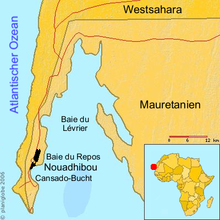
Since dismantling, i.e. dismantling and scrapping, for example in a special scrapping yard , is usually only worthwhile for very large ships, there are ship cemeteries on many coasts or banks around the world due to ships that have decayed.
Nouadhibou (Mauritania)
The world's largest decaying ship cemetery is located in Cansado Bay and the Baie du Repos in front of Nouadhibou (formerly Port-Étienne), the second largest city in Mauritania (West Africa). In 2004, an expedition from Oxford University counted 104 ships that at least partially protruded above the surface of the water, and 22 ships below the surface. Most of the ships are large fishing vessels that were abandoned after 1984, when Mauritania established a national fishing fleet and inexperienced fishermen - partly because of overfishing - bought unprofitable or in poor condition ships and later left them to deteriorate.
An attempt by the Ministry of Fisheries to clear the ship's graveyard failed in 1999 due to protests by the ship's owners. Since the Nouadhibou ship cemetery poses an environmental risk - mainly due to oil losses - and also hinders shipping traffic in the shallow fairways to the port, the European Union provided 26.2 million euros in 2006 for the disposal of 55 of the wrecks and their transport to one Storage site provided in the north of the bay ( Plage Nord ).
Lagos (Nigeria)
Another very large ship cemetery is located off the coast of the port city of Lagos in Nigeria . The numerous wrecks not only endanger the environment and shipping off the Nigerian coast, they also represent a hiding place that is difficult to access for criminals.
Abidjan (Ivory Coast)
Another ship cemetery due to decay has been in front of the Abidjan district (until 2002: Abidjan city) in Ivory Coast since around 1990 . With the ships blocking the port, Abidjan tried to auction the ship cemetery on eBay in 2000 . The prerequisite for the purchase was that the entire ship graveyard and not just individual ships would be purchased. The outcome of the auction is unclear; Since there are still ships in the Ébrié lagoon , it can be assumed that no bidder was found or that at least some of the ships were not removed, but only towed into this area of the lagoon.
Murmansk (Russia)
At the largest location of the Russian Northern Fleet in Murmansk ( Severomorsk , Belokamenka and other places), several hundred old nuclear submarines and warships are anchored waiting to be demolished. Since it would be necessary to dispose of the nuclear propulsion systems for nuclear submarines, for example, the demolition of such ships - unlike the usual scrapping in a scrapping yard - does not generate any profit, but generates costs. A schedule for the scrapping of the ships in Murmansk is therefore not yet available, so that the ships have since decayed and in individual cases have already sunk to the bottom of the port.
More ship cemeteries due to decay

In addition to the large ship cemeteries, there are many places where ships are left to decay in ports or former shipyards. This includes, for example, part of the port of Mar del Plata in Argentina, which has become a destination for backpackers, not least because of a colony of mane seals that live on the ships . Another ship cemetery is located to the west of Staten Iceland in the US state of New York , on the banks of the tidal waters for Arthur Kill .


The Aral Sea between Uzbekistan and Kazakhstan is a special case - due to the dramatically falling water level, the former banks have often shifted many kilometers. The former port of the former fishing town of Mo'ynoq is now more than 100 kilometers from the shore. Ships that are no longer used for economic reasons (fish deaths) or because of the shrunken lake are now rotting in some places on dry land in the middle of the Aralkum desert .
In addition, in many areas, individual and especially smaller ships along coasts or banks are left to decay. For example, along the Breton coasts and estuaries, individual or rotting wooden hulls can be seen in many places. Due to the small number of ships (in Brittany, for example, rarely more than three ships together), such places are not always referred to as the usual ship cemeteries.
Since even smaller ship cemeteries often lead to environmental damage, they are less common in industrialized countries or are sometimes removed at great expense.
See also
literature
- Peter Baumann: Great moments in ship archeology. Econ, Düsseldorf 1988, ISBN 3-430-11224-9 .
- Ludwig von Reuter : Scapa Flow. The grave of the German fleet. Koehler, Leipzig 1921 (reprint. Melchior-Verlag, Wolfenbüttel 2008, ISBN 978-3-939791-42-3 ( historical library )).
- Robert Ballard with Rick Archbold: Sunk in the Pacific. Guadalcanal Ship Cemetery. Ullstein, Munich 1999, ISBN 3-548-24605-2 .
- Andreas Krause: Scapa Flow. The sinking of the Wilhelmine fleet. Ullstein, Munich 2001, ISBN 3-548-25081-5 .
Web links
- Per Hoffmann, Martin Mainberger: Catalog of the archaeological ship and boat finds in Germany
- Current data on scrapping http://hochhaus-schiffsbetrieb.jimdo.com/abwracken/
- Naval Battle of Lepanto
- Report on the first find ( memento from June 19, 2004 in the Internet Archive ) (information on a broadcast by ZDF Expedition)
- Film clips on ARTE.tv
- Self-immersion
- Current data on scrapping http://hochhaus-schiffsbetrieb.jimdo.com/abwracken/
- Positions of the sunk German deep sea fleet
- Wreck of the SMS Köln, a ship of the German deep sea fleet, in Scapa Flow
- Diving in Scapa Flow: SMS Cologne
- Operation Deadlight at UBoat.net (English)
- Wreck diving
- Wreck diving site with an archive of over 3,800 wrecks in the North Sea, around Great Britain and off the Belgian and Dutch Channel coasts , very extensive documentation
Footnotes
- ↑ Website of the Chilean Kaphoorniers: Symbol of Amicale (switch to English) (accessed November 23, 2006)
- ↑ Notices to Navigators (NfS) Nautical Warning and Intelligence Service, United Kingdom UK Hydrographic Office, Taunton Somerset
- ^ David Wilma: Graveyard of the Pacific: Shipwrecks on the Washington Coast. In: HistoryLink.org. Retrieved September 14, 2018 .
- ↑ This number was obtained from a December 2008 search of the Underwater Archeology Branch (UAB) database of the Office of State Archeology (OSA) of North Carolina. according to Richard W. Lawrence (2011). Forty Years Beneath the Waves: Underwater Archeology in North Carolina (= Chapter 12). in: Charles R. Ewen, Thomas R. Whyte & RP Stephen Davis, Jr. (Eds.): The Archeology of North Carolina: Three Archaeological Symposia. Publication 30, North Carolina Archaeological Council.
- ↑ Paul M. Hudy (2007). The Ghost Fleet of the Graveyard of the Atlantic. Shipwrecks of North Carolina. Map of 138 wrecks, on nc-wreckdiving.com (accessed November 27, 2019)
- ^ Excerpts from the script of the documentary The Sea Battle of Lepanto by Marc Brasse; Printed on www.arte.tv ( Memento from September 29, 2007 in the Internet Archive ) (accessed March 6, 2007)
- ↑ a b Dive into the past - The sea battle of Lepanto. Information on the program "ZDF Expedition", August 10, 2004, 3:15 pm ( Memento from October 25, 2005 in the Internet Archive ) (accessed March 6, 2007)
- ↑ Loch Ryan in the English language Wikipedia
- ↑ Lisahally in the English language Wikipedia
- ↑ A reason to cry, on home.datacomm.ch (August 2001 - From all over the world - accidents) (from August 3, 2001, last accessed on May 5, 2010)
- ↑ Mauritania. Fishing on www.nationsencyclopedia.com (accessed March 4, 2007)
- ↑ Commission provides € 26 million for a project to salvage shipwrecks in the Bay of Nouadhibou in Mauritania (PDF) , accessed on September 13, 2010
- ↑ Christian Putsch: The steel frame in the world's largest ship cemetery , Die Welt , May 9, 2012
- ↑ http://www.presseportal.de/pm/6657/121255/ebay-ein-schiffsfriedhof-wird-versteigert-schiffswracks-vor-afrikanischer-kueste-kommen-unter-den
- ↑ Provide individual evidence according to WP: BLG .
- ↑ z. B. Clearance of the former Herman Melville shipyard in New Bedford ( Massachusetts , USA): EPA to clean ship graveyard area (for immediate release: April 9, 2002; Release # 02-04-08) on www.epa.gov ( Environmental Protection Agency) (accessed March 4)


